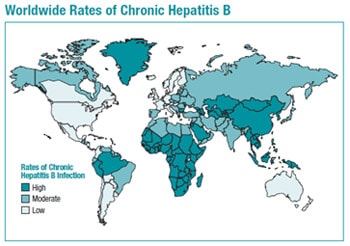People Born Outside of the United States and Viral Hepatitis
People born in any country with a medium-to-high prevalence of hepatitis B (>2%) should be tested for chronic hepatitis B.
Non-U.S.-born people account for 70% of all chronic hepatitis B infections in the United States. CDC recommends hepatitis B testing for:
- People born in any country with medium-to-high prevalence of hepatitis B (>2%). This includes all countries in Asia, the Pacific Islands, and most African countries, especially countries in Sub-Saharan Africa.
- People born in the United States who were not vaccinated at birth and have at least one parent born in a country with high prevalence of hepatitis B (>8%). This includes all countries in East and Southeast Asia (except for Japan), the Pacific Islands, and Sub-Saharan Africa.
CDC also recommends one-time hepatitis C testing of all adults (18 years and older) and regular testing for people with risk factors.
Asian Americans, Pacific Islanders, and People Born in Africa at Increased Risk for Hepatitis B
Many countries in Asia, the Pacific Islands, and Africa have high or moderate prevalence of chronic hepatitis B (see map below). The overall prevalence of hepatitis B in the WHO Western Pacific Region is about 6.2%, and nearly 70% of Asian Americans were born outside of the United States. Asian Americans make up 6% of the total population in the United States, but account for 58% of the 862,000 Americans living with chronic hepatitis B. Prevalence is also high among Pacific Islanders living in the United States. The overall prevalence of hepatitis B in the WHO African Region is 6.1%, although certain African countries are experiencing a much higher burden of infection (e.g., Somalia, Zimbabwe, Eritrea, Sudan, Nigeria, and Liberia). During the past 3 decades, migration from an African country of origin to the United States has increased from 200,000 to 1.7 million people. Of people living with chronic hepatitis B in the United States, 12% were born in Africa.
CDC has developed resources, such as fact sheets and community mobilization toolkits, to help educate people born in these countries about the importance of hepatitis B testing.

For additional information on other groups that should be tested for hepatitis B, see: Recommendations for Identification and Public Health Management of Persons with Chronic Hepatitis B Virus Infection [PDF – 28 pages]
Scientific Guidelines and Recommendations
Chronic Hepatitis B Testing
- Recommendations for Identification and Public Health Management of Persons with Chronic Hepatitis B Virus Infection [PDF – 28 pages]
- U.S. Preventative Services Task Force (USPSTF) – Screening for Hepatitis B Virus Infection
Hepatitis B Vaccination
- Prevention of Hepatitis B Virus Infection in the United States: Recommendations of the Advisory Committee on Immunization Practices
MMWR 2018;67(No. RR-1):1–31
Health-care Provider Resources
- AASLD: Update on prevention, diagnosis, and treatment of chronic hepatitis B: AASLD 2018 hepatitis B guidance
- CDC: Recommendations for Hepatitis C Screening Among Adults, United States — 2020
- Hepatitis B Vaccination, Screening, and Linkage to Care: Best Practice Advice from the American College of Physicians and the Centers for Disease Control and Prevention
- Testing Asian Americans and Pacific Islanders for Hepatitis B [PDF – 2 pages]
- Geographic Distribution of Chronic Hepatitis B virus (HBV) Infection [PDF – 1 page]
- Hepatitis B Information for Health Professionals
- Testing Recommendations for Chronic Hepatitis B Virus Infection
- Recommendations for Routine Testing and Follow-up for Chronic Hepatitis B Virus Infection
Printable document [PDF – 2 pages] - Interpretation of Hepatitis B Serologic Test Results
Patient Resources
- Hepatitis B Patient Education Resources
- CDC’s Know Hepatitis B campaign targeting AAPIs to get tested for hepatitis B